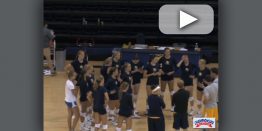Coach Bond Shymansky explains the Avalanche drill and his squad performs it.
Club Volleyball Off-Season Strength and Conditioning Program – The Outside Resource Model
One of the most difficult tasks in club volleyball is to create an offseason program that produces results. There are two ways to do this: in-house at the club or utilizing outside recourses to get the job done. In this article, we’ll take a look…
Individual Defense – Kevin Hambly – Univ. of IL
Coach Kevin Hambly discusses and players demonstrate back up, stopping and playing defense
Volleyball Recruiting: Searching for More Than Talent
“Play as much as possible.”
That’s what most volleyball recruits think college coaches want them to do before they make it to the next level. But in the eyes of a recruiting college volleyball coach, recruits should be doing many other things—
Defense to 100 Drill
This drill is a tremendous opportunity to work on overlapping areas, verbal communication, and movement.
Purpose
To provide repeated opportunities for a team to dig balls on defense.
Setup
Two coaches or other consistent attackers set up…
Double-Sided Swing Hit
Objective: Train players to serve receive then swing hit down the line. Serve receive training
Equipment Needed: 15-20 balls, 2 ball carts, 2 extra antennas
Directions: Divide your team into two groups.
Warm Up: Catch Games with Leisa Rosen – Univ. of Michigan
Coach Leisa Rosen explains and players demonstrate these Warm Up – Catch Games
Setting Footwork Drills with Anne Kordes
Coach Anne Kordes explains and players demonstrate these Setting Footwork Drills
Keys for Passing: Face the Line of the Ball with Kevin Hambly
Coach Kevin Hambly explains and players demonstrate this Passing Drill
Double Jump Drill
One athlete with ball on each of the two hitting boxes at net, 10 feet apart.
Athlete holds the ball above the plane of the net.
Three blockers – one at net in front of left side athlete/box. Other two blockers in line ready to enter drill…
Block Party: Adjusting to the Pace
In today’s game, opposing offenses are bringing more attackers at a faster pace, putting more stress on blockers and defense than ever before. Four or five attackers vs. three blockers does not equate well for the defense. So how does your block…
Warm Up Passing Drill – Bala Spencer – Kamehameha Schools (HI)
Coach Bala Spencer explains and players demonstrate this warm up passing drill
4 v 4 Defensive Drill – Matthew Cribbin – American International College
Coach Matthew Cribbin explains and players demonstrate this defensive drill
Expecting Greatness
Being pregnant during season was great! All my cravings were fulfilled: from buffet for breakfast (right up my alley) to dessert for dinner (“I am having a craving!”). On a serious note, I had great role models like my mother, my high school coach…
A Look at the University of Minnesota’s Ideal Strength and Conditioning Program
“There is no best strength and conditioning program, only an ideal one.”
We just finished a three part series on the University of Minnesota’s approach to strength and conditioning in the last issue of Performance Conditioning Volleyball. This…
Ultimate Volleyball Workout
To be a great volleyball player you need speed, quickness and crazy jumps. What is the “best workout” to develop a championship-caliber volleyball player?
If you are tight on time, this is the workout for you. It includes only four exercises…
ACL Injuries: The Concussion of the Knee?
The concussion buzz continues. The NFL has just launched a new “Heads Up Football ” youth football program aimed at stopping the exodus of young boys from playing tackle football (USA Football reports the estimated number of participants at 2.82…
Volleyball Workout Do’s and Don’ts
Volleyball has specific physical demands. You must have speed, power and agility with short rest intervals. Since you don’t want to waste time training skills that won’t help you in your sport, let’s look at some common volleyball workout…
2 Speed Drills to Improve Your Volleyball Game
Volleyball is a game of quick feet and fast reactions. Most movements are performed in 3- to 5-step patterns, so it is critical for players to master first step speed mechanics.
Going from a dead stop to full speed in a few steps requires a…
Increase Your Vert for Volleyball With 3 Plyos
Volleyball players must have a big vert. Jumping high helps you deliver ferocious spikes and be a defensive force on the court. And the best way to improve this skill is with plyometrics—but not everyone understands this type of exercise.
Avoid Low Back Pain With This Stretching Technique
Sore low backs are common among volleyball players midway through the season. Despite their athleticism and dedicated training, many players suffer from back pain. The cause is simple to diagnose but hard to treat. Volleyball players move in short…
Swing Mechanics: “Getting Into the Swing of Things”
Attacking the ball is no different than hitting a baseball, swinging a golf club or serving a tennis ball: mechanics are everything! Let’s be very clear here from the beginning — an athlete does NOT have to be jacked or super-buff to bring the heat.
3 Fun and Effective Volleyball Serving Drills
The skills of a successful volleyball athlete are learned in practice, including becoming an effective server. Practicing serving is as important as any hitting, setting or passing drill, especially when the exercise mirrors a real game scenario.
Serving and Passing Butterfly
Directions:
Team 1 serves to Team 2 and vice versa.
Give a point, for every 3 ball pass a team executes. Goal is to get 50 passes in 5 minutes.
After 5 minutes…
Check Your Distance, Out of the Net, and Under-the-Net Digging
Purpose
To help players establish a starting distance in relation to the net when blocking and to maintain that distance after moving.
Setup
One player begins at the net in the middle in a blocking ready position. Additional players line up…
Cross Court
Two teams consisting of two hitters and a setter set up on each side of the court, with one hitter located in left front (LF) and the second hitter in left back (LB). The setter (S1) is located in right front.
Divide the court in half the long…
Defensive Drills
Purpose
To encourage players to be quick to receive the ball and to score on the opponent.
Setup
Three players spread out on each side of the court. The coach is off the court near the midline with a basket of balls and a feeder.
Defensive Systems
In all my years of coaching, I always felt that defense – individual player and “team” is the tactical area that will determine what team will ultimately win. No doubt, you have heard the coaching cliché – “Defense Wins Championships.” Good and…
Positioning Defensively as a Team
When on defense, having all your players in the correct position on the court no matter what defensive system the team is playing allows a team to be successful. If the players are in the correct position it means the court is balanced, which…
Defense of Choice: Choosing the defense that’s best for your team
When preparing your team for a season, coaches talk about players, what positions they will play and what will work best with their program. Once positions are settled and it comes time to put the team together on the floor, from a defensive…
































